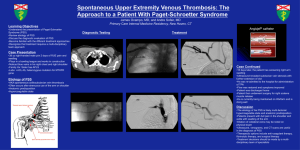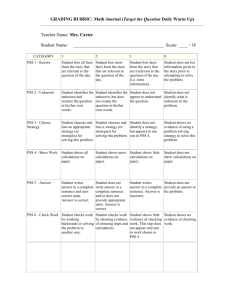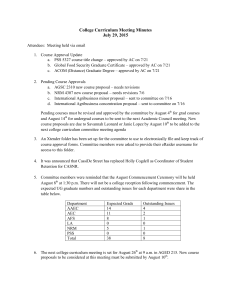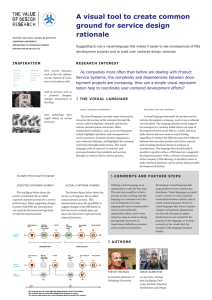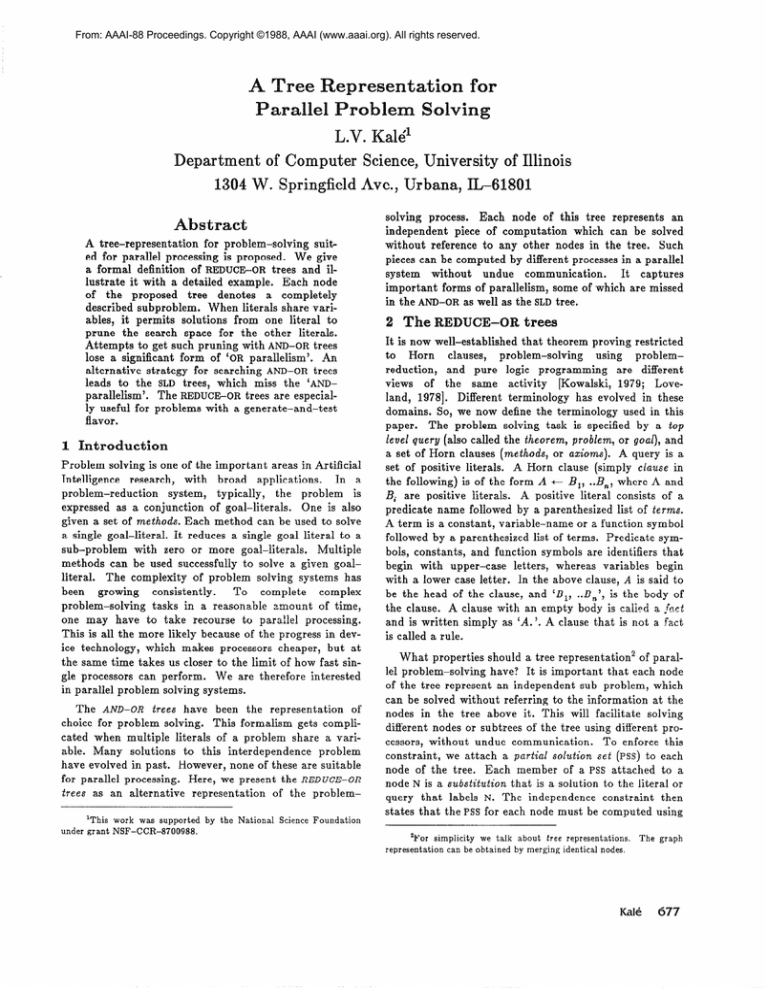
From: AAAI-88 Proceedings. Copyright ©1988, AAAI (www.aaai.org). All rights reserved.
sentatisn for
ving
L.V. Kal&
Department
of Computer
Science, University of Illinois
1304 W. Springfield Ave., Urbana, IL-fil$Ol
Abstract
A tree-representation for problem-solving suited for parallel processing is proposed. We give
a formal definition of REDUCE-OR
trees and illustrate it with a detailed example. Each node
of the proposed tree denotes a completely
described subproblem. When literals share variables, it permits solutions from one literal to
prune the search space for the other literals.
Attempts to get such pruning with AND-OR trees
lose a significant form of ‘OR parallelism’. An
trees
alternative strategy for searching AND-OR
leads to the SLD trees, which miss the ‘ANDparallelism’. The REDUCE-OR
trees are especially useful for problems with a generate-and-test
flavor.
1 Introduction
Problem solving is one of the important areas in Artificial
In a
Intelligence research, with broad applications.
problem-reduction
system, typically, the problem is
expressed as a conjunction of goal-literals.
One is also
given a set of methods. Each method can be used to solve
a single goal-literal. It reduces a single goal literal to a
sub-problem with zero or more goal-literals.
Multiple
methods can be used successfully to solve a given goalliteral. The complexity of problem solving systems has
To complete
complex
consistently.
been growing
problem-solving tasks in a reasona,ble amount of time,
one may have to take recourse to parallel processing.
This is all the more likely because of the progress in device technology, which makes processors cheaper, but at
the same time takes us closer to the limit of how fast single processors can perform. We are therefore interested
in parallel problem solving systems.
The AND-OR
trees have been the representation of
choice for problem solving. This formalism gets complicated when multiple literals of a problem share a variable. Many solutions to this interdependence problem
have evolved in past. However, none of these are suitable
for parallel processing. Here, we present the REDUCE-OR
trees as an alternative representation of the problem‘This
under grant
work was supported
NSF-CCR-8700988.
by the National
Science
solving process. Each node of this tree represents an
independent piece of computation which can be solved
without reference to any other nodes in the tree. Such
pieces can be computed by different processes in a parallel
It captures
system without undue communication.
important forms of parallelism, some of which are missed
in the AND-OR as well as the SLD tree.
UGE-
R
trees
It is now well-established that theorem proving restricted
to Horn clauses, problem-solving
using problemreduction, and pure logic programming are different
views of the same activity [Kowalski, 1979; Loveland, 19781. Different terminology has evolved in these
domains. So, we now define the terminology used in this
paper. The problem solving task is specified by a top
level query (also called the theorem, problem, or goal), and
a set of Horn clauses (methods, or asioms). A query is a
set of positive literals. A Horn clause (simply clause in
the following) is of the form A + B,, ..B,, where A and
Bi are positive literals. A positive literal consists of a
predicate name followed by a parenthesized list of terms.
A term is a constant, variable-name or a function symbol
followed by a parenthesized list of terms. Predicate symbols, constants, and function symbols are identifiers that
begin with upper-case letters, whereas variables begin
with a lower case letter. In the above clause, A is said to
be the head of the clause, and ‘B1, ..B,‘, is the body of
the clause. A clause with an empty body is called a fo,ct
and is written simply as ‘A. ‘. A clause that is not a fact
is called a rule.
What properties should a tree representation2 of parallel problem-solving have ? It is important that each node
of the tree represent an independent sub-problem, which
can be solved without referring to the information at the
nodes in the tree above it. This will facilitate solving
different nodes or subtrees of the tree using different processors, without undue communication.
To enforce this
constraint, we attach a partial solution set (PSS) to each
node of the tree. Each member of a PSS attached to a
node N is a substitution that is a solution to the literal or
query that labels N. The independence constraint then
states that the PSS for each node must be computed using
Foundation
2For simplicity
we talk about tree representations.
representation
can be obtained by merging identical nodes.
The graph
Kale!
677
information from the PSS’Sof its children only.
Another important criteria is the ability to handle
sub-problems
containing literals that share variables.
Consider the query (admittedly contrived): ‘Square(lO,x),
Cube(x,y)‘. Th’1s requests finding values for x and y such
that x is square of 10, and y is the cube of x. If the subproblems are solved independently, the search space for
Cube(x,y) is very large, even if we constrain all the
numbers to be less than some upperbound. Instead, if we
let the solution (or solutions, in the general case) of
Square(lO,x) to constrain the search space of Cube(x,y),
we get a much smaller search space. One must then
allow for and handle such ordering constraints. Notice
that the order doesn’t have to be total. In the clause for
s in Figure 1, once a binding for x has been obtained by
solving P(t,x), no further reduction in search space can be
obtained by enforcing any order between Q and R. Any
such ordering destroys opportunities for parallelism. So:
Instead of just as a set of literals, the top level query as
well as bodies of all clauses are assumed to be specified as
partial orders. We represent this partial order in a graph
notation called the Data Join Graph (DJG). Each literal
of the query is an arc of a DJG. The nodes of the graph
are joining points for data coming from different arcs.
There is a single start node, with no incoming arcs, and a
single finish node, with no outgoing arcs, in a DJG.
A few points should be noted. We do not require that
when two or more literals share a variable, one of them
must dominate the others in the partial order, i.e., that
there be a single generator literal for every variable. In
some cases, it may be more efficient to solve two literals
sharing a variable independently, and then intersect the
solutions. Conversely, sharing of variables is not necessary to impose an ordering. For example in ‘GEN(X),
TEST(x), EXTEND(x,y)‘, 1
‘t may be prudent to wait for a
certification from TEST, before wasting the efforts on
extending the binding produced by GEN. Also, for some
clauses, one order may be more efficient than another
depending on (the values of variables in) the invocation.
Here we assume for simplicity that a fixed DJG is used for
every invocation. Preliminary ideas on some extensions to
allow ‘runtime’ choice of graphs are in [Kale, 19851.
Consider the problem specified in Figure 1. (The
figures appear at the end of the paper). The AND-OR tree
for this problem is shown in Figure 2. Examining this
tree in view of the criteria stipulated above, one notices
some deficiencies in the representation.
The independence criteria requires that P, Q and R be solved
independently; then there is no way to constrain the
search space for Q and R using the solutions obtained
from P. Even if we ignore this constraint (accepting the
resultant communication penalty, or limiting it by using
a shared memory system), the AND-OR trees run into
other serious problems.
As shown in Section 3, all
attempts to use the AND-OR tree in such a situation lead
to either the loss of parallelism between Q and R (the AND
678
Machine Architectures and Computer Languages for AI
parallelism) or the loss of OR parallelism
exploring multiple solutions provided by P.
in further
The REDUCE-ORtree for this problem is shown in Figure 3. The details are explained after the formal
definition of these trees. Notice that there are multiple
(two) nodes for different instances of literals Q and R.
This is a major difference between the AND-OR trees and
the REDUCE-OR trees. Another difference is the PSSs
attached to all the nodes via dotted lines. Each REDUCEnode except the root corresponds to a clause of the program. (Many nodes may correspond to a single clause, in
general). It is written as R(H,p,pSS),
where H is instantiated head of some clause C, and P is a partial order
comprising the instantiated literals in the body of C. PSS
is a set of substitutions that satisfy the literals in P, and
hence H. In diagrams, a REDUCEnode is denoted by a
rectangle, with the head (H) in a box at its top left
corner, and the DJG for P in the middle. The PSS is drawn
as a box with double lines at the top. The OR node is
written as 0 (a,G,PSS), where Q is a substitution, G is a
literal, and PSS is a set of substitutions that satisfy G. It
is diagrammed as an oval, with CTin the upper half, and
G in the lower. c stores the context of an OR-node as
explained below.
Fsrmal Definition:
The REDUCE-ORtree for a query &,
w.r.t. a logic program P, is defined using mutually recursive rules. Rules (1) and (2) specify how to build the tree,
and the rules (3) and (4) specify how to collect the PSSS.
The root of the tree is R (d,Q ,PSS).
RULE
1:
The
children
of
a REDUCE-node:
Let
be a REDUCE-node. Select a literal, say Gk E
P. Let P,,..P,
be the predecessors of G, in the partial
order P.. Select one OR-child for each i, 1 5 i 5 m, say
(Pi’ is an instance of Pi.>. Frqm each
O(Oi: ,Pi’,PSSi’).
PSSi’,
*select one substitution,
say SiJEPSSi’ . Let
pi = Qi’ $.J and (T= ?r,*7r2*
.* *riT,. For each combination
of such selections, if the resultant CTis a consistent substitution, then there is a new OR-child : O(a,aGk,PSS’).
The first argument, cr, essentially remembers the ‘context’
of the OR-node. Without such a (T, the REDUCE-node Rl
of Figure 2 would have no way of knowing that {x=A,
y=D, z=F} is not a solution.
Informally: there is an OR-node for solving an instance of
a literal 6, in P for every consistent composition of a
solution to each predecessor of Gk in P.
Note that if 1P I=O, (the node corresponds to a fact),
there are no children.
R(H,P,PSS)
RULE 2: children of an OR-node:
Let O(c,G,PSS) be an
OR node. For each clause of the form ‘Hi:-Qi’ such that
G, the OR node has a child
unifies with
Hi
R(eHi,e9i,PSSi).
H ere 19is the most general substitution
to the variables of Hi so that it matches G. (i.e.,
0 Hi = wG for some 7r). &,. is a partial order of literals.
RULE 3:
Let 0 (a,G,PSs)
Then,
{R(Hi,Qi,PSSi)}.
be an OR-node with children
PSS = { $1 tiG=?r,.H,., where 7r,.EPSS,., for some a}.
Informally: any solution to a REDUCE-node translated via
back-unification is a solution to its parent OR-node.
RULE 4: Let R(H,P,PSS)
b e a REDUCE-node, where the
partial order consists of literals G,,G ,..G.,. Let the children of this node be denoted { 0 (ai3?Gi’ ,PSS~‘)}, where
Gi’ is an instance of Gi. Then,
. .
P+s={ 8 f ~=Rpr$
. . wiT,where xj=~!+i,
for some j, with
6$.‘EPSSj’,
8 consistent }*
Informally: a consistent composition of solutions to each
literal of a clause is also a solution to its head.
Notice the special case: R(H,{},{ @}). i.e. the PSS for a
REDUCE node corresponding to a faet is a singleton set
with a null substitution.
We now illustrate the rules using the tree of Figure 3.
Application
of Rule 2: the topmost OR node in the tree is
O(#,S(I,u,v),PSS). To generate its child, we use the only
clause whose head unifies with S(I,u,v).
Solving
eS(t,y,z)=7rS(I ,u,v) for a most general substitution 8 we
find 0={ t=I} (with z = {u=y,e)=z}).
So, we get the
child REDUCEnode: R(e S(t,y,z), B {P&,x), Q(x,y), R(x,z)},
PSS), which together with the DJG for the clause leads to
the node in the Figure.
Application
of Rule 1: Consider the REDUCEnode created
in the application above. We select G, = R(x,z) from the
DJG of this REDUCEnode. There is only one predecessor
literal, P(l,x), and there is only one OR-child labeled with
an instance of this. So we select 6,’ = {x=B} from the
appropriate PUS. As the ‘context’, olj, for that OR node is
empty, rl=bl . J&o, because there is only one predecessor, t.T=7T1=
{x=B}.
So, we create an OR node:
which appears at the bottom right
O(-tx=BhR(W)PSS),
in Figure 3. A more illuminating example would arise if
the DJG contained another literal, T(x,y,z), which has all
the other literals as predecessors. To understand the full
generality of Rule 1, the reader should follow the creation
of an OR node for an instance of T in that case.
Application
of Rule 4: The topmost binding, say 8,, in
the PSS of the REDUCEnode Rl with variables x,y and z is
obtained using the PSSs of the OR nodes labeled P(I,x),
Q(B,y), and R(B,z) as: 8, = “1’7r~‘7r’3= a~++$+~
=
{}~{x=B}~{x=B}*{~=D}~{x=B}*{z=F}={x=B,
y=D,z=F).
(The j values have been arbitrarily assigned). Notice that
picking the substitution {x=A}
from PSS: does not lead
to a consistent solution only because it conflicts with al
and al, thus justifying the need to maintain the ‘context’
in Q at all OR nodes.
Application
of Rule 3: The topmost substitution in the
PSS of the topmost OR node is found by solving for a 13
such
that
I~s(I,u,u)=~~s(I,x,~)
where
?r,={ x=B,
y=D,z=F).
It can be shown that a substitution B appears in the
PSS of a REDUCE-node labeled with a query Q, if f 8& is a
consequence of the clauses used to obtain the tree. We
omit the proof here for lack of space.
3 Comparisons
AND-OR trees have been used to represent problem solving since the early days of AI [Gelernter, 1959; Slagle, 19631. Early problem solving systems did not explicitly provide for sharing of variables among subproblems,
and indeed many interesting problems can be solved
using decomposition into independent subproblems only9
without any sharing across literals [Slagle, 19931. The
problems arising out of such sharing were soon noticed,
as demonstrated by the well-known Fallible Greek example (see [Levi and Sirovich, 1976; Loveland
and
Stickel, 19761). Definitionally, the problem was handled
with the notions of candidate solution graphs, and consistent solution graphs (CSG) [Nilsson, 1980]. A candidate solution graph for an AND-OR tree includes the root;
Whenever it includes an AND node, it includes all its children, and whenever it includes an OR node, it includes
one of its children. A solution graph is consistent if the
unifying composition of substitutions on all its match
arcs is consistent. The operational aspect of the problem
was how to search the AM)--OR tree for a CSG.
A simple strategy would be to pass upwards the set of
solution bindings found at nodes in the tree, merging
them at the OR nodes and joining them at the AND nodes
to ensure consistency. However, as we saw in section 2,
this does not let the solutions to one literal constrain the
search space for the others.
Nilsson [Nilsson, 19801 discusses the importance of
early pruning and suggests a strategy to detect inconsistent partial solution graphs. This can result in pruning only if one of the subgoal has produced a binding,
and no alternate binding is possible within the tree for
that subgoal. So, this approach won’t lead to any pruning in the problem of Figure 1, and may lead to full
exploration of the subtree for Q(x,y), for example.
Another approach is to force each AND node to maintain a single consistent binding at a time [Conery and
Kibler, 19851. The OR nodes send up only one solution,
and wait until the parent AND node detects some inconsistency, and asks for another solution (backtracks into
the OR node). In Figure 2, once P sends a solution,
{x=A}, Q are R can be started in parallel, with the constraint {x=A} helping to prune their search space. This
also permits a form of OR parallelism since alternate
methods beneath P can be working on different solutions
to P at the same time. But, as only one solution can be
passed up, this misses a form of OR parallelism involved
in exploring multiple instances of Q (or R) in parallel.
Levi and Sirovich [Levi and Sirovich, 19761 define a
search tree in which nodes represent proof trees (partial
solution graphs), and branches are choice points. These
trees turn out to be identical to the SLD trees [Kowalski
and Kuehner, 19711. (Logic programming systems search
these trees depth-first, with a more efficient variable
representation than proposed in [Levi and Sirovich, 19761
KalC
679
and eliminate their AND operator used to avoid backtracking the bindings. See [Bruynooghe, 19823 for a connection between them, although the ideas remained
unconnected in that paper). This effects the pruning we
desire, and also permits OR parallelism.
However, it
misses the AND parallelism now. As we can see in the SLD
tree of Figure 4, Q and R have to be solved sequentially in
all branches. Also, there are redundant subtrees in SLD
trees whenever they contain independent AND subproblems: The two subtrees for R are identical in our example. The duplication can be avoided even on parallel processors using a method in [Ullman, 19841.
Thus, the attempts to adapt the AND-OR
trees for
parallelism run into three problems. Some lose the ability to prune the search-space in the case of shared variables. Others miss either the AND parallelism, or a form
of OR parallelism.
A model proposed independently
in [Singh and
Genesereth, 19861 leads to trees similar to ours. However, it combines the OR nodes for a literal, and imposes
an ordering on streams of bindings flowing through these
nodes. As a result, it loses some parallelism, and is
incomplete when the trees may contain infinite branches.
It is thus similar to [Li and Martin, 19861 and
[Wise, 19821 analysed in [Kale, 1987a].
4 Discussion
The parallelism exploited by the REDUCE-OR
trees is best
illustrated in generate and test computations.
Generate
must happen before test (‘pruning’), may be AND parallel,
and may return multiple candidates to be tested. We are
able to exploit all these sources of pruning and parallelism, including that between tests for different candidates.
The REDUCE-OR
trees were informally introduced in
[Kale and Warren, 19841, which discusses the interconnection topologies suitable for parallel Prolog. We are
developing a process model for parallel evaluation of
Logic programs [Kale, 1987b]. based on REDUCE OR trees.
It finds every solution even when the tree contains infinite
branches.
The process model provides efficient algorithms and data structures to use the tree-representation
effectively. For example, it avoids the redundancies
involved in computing consistent compositions of substitutions from the PSS’ of children OR nodes. Extensions
into heuristic problem solving are also planned.
References
[Bruynooghe, 19821 M. Bruynooghe,
“The
memory
management of PROLOG implementations”, in Logic
Programming, K. L. Clark and S. Tarnlund, (eds.),
Academic Press, 1982, 83-98.
[Conery and Kibler, 19851 J. S. Conery and D. F. Kibler,
and Non-Determinism
in Logic
“AND-parallelism
Programs”,
New Generation
Computing,
8, (1985),
43-70.
680
Machine Architectures and Computer Languages for AI
[Gelernter, 19591 H. Gelernter,
“Realization
of a
Geometry Theorem-Proving
Machine”, Proc. First
International
Conf. on Information
Processing,
Paris:
UNESCO, 1959.
wale and Warren, 19841 L. V. Kale and D. S. Warren,
“A Class of Architectures for Prolog Machine9’, Proc.
of
the
Conference
on Logic
Programming,
Uppsala,
July 1984, 171-182.
[Kale, 19851 L. V. Kale, “Parallel Architectures for
Problem
Solving”,
Doctoral
Thesis,
Dept.
of
Computer Science, SUNY, Stony Brook, Dec. 1985.
Sweden,
[Kale, 1987a] L. V. Kale, “‘Completeness’ and ‘Full
Programming
Parallel
Logic
Parallelism’
of
of 1987 Symposium
on Logic
Schemes.“,
Proc.
Programming, San Fransisco, 1987, 125-133.
[Kale, 1987b] L. V. Kale, “Parallel execution of Logic
Programs: the REDUCE-OR process model”, Proc. of
Fourth
Conference
International
on
Logic
Programming, May 1987, 616-632.
[Kowalski and Kuehner, 19711 R. Kowalski and D.
Kuehner , “Linear Resolution with selection function”,
Artificial Intelligence,
2, (1971), 227-260.
[Kowalski, 19791 R. K owalski, in Logic for Problem
Solving, Elsevier North-Holland, New York, 1979.
[Levi and Sirovich, 19761 G. Levi and F. Sirovich,
“Generalized And/Or Graphs”, Artificial Intelligence
7(3),
1976.
[Li and Martin, 19861 P. P. Li and A. J. Martin, “The
Sync Model: A Parallel execution method for logic
programming”, Proc. of the third symposium on logic
Salt Lake City, Sept. 1986, 223-234.
programming,
[Loveland and Stickel, 19761 D. W. Loveland and M. E.
Stickel, “A Hole in Goal trees: some guidance from
resolution theory”, IEEE Trans. on Comp. C !?5(4),
1976, 335-341.
Theorem
[Loveland, 19781 D. W. L oveland, Automated
Proving, North Holland, 1978.
of Artificial
[Nilsson, 19801 N. J. N i 1sson, in Principles
Intelligence,
Tioga Publishing Co., 1980.
[Singh and Genesereth, 19861 V. Singh and M. R.
Genesereth, “PM: A parallel execution model for
KSL-85-18,
deductions”,
backward-chaining
Science,
Stanford
Department
of
Computer
University, May 1985, revised June 1986.
[Slagle, 19631 J. R. Slagle, “A heuristic Program that
solves symbolic integration problems in Freshman
calculus”, J. ACM, 10, (1963), 507-520.
[Ullman, 19841 J. D. Ullman,
“Flux,
Sorting and
Supercomputer Organization for Al Applications”,
Journal
of
Parallel
and
Distributed
Computing,
1,
(1984), 133-151.
[Wise, 19821 M. J. Wise, “A parallel Prolog: the
construction of a data driven model”, Proceedings
of
Functional
and
the
1982
Conference
on
Lisp
Programming, 1982, 56-66.
Figure
1: A Problem Specification
Figure
Figure
2: An AND-OR
4: A SLD Tree
Tree
Rl
I
Figure 3: A REDUCE-OR Tree
Kale
681

